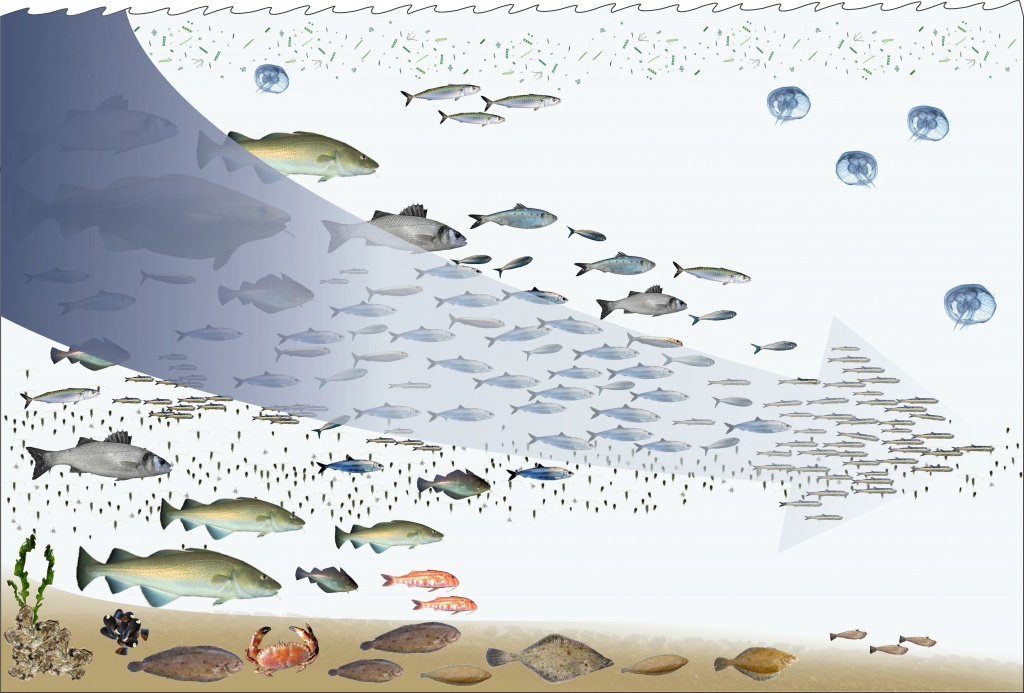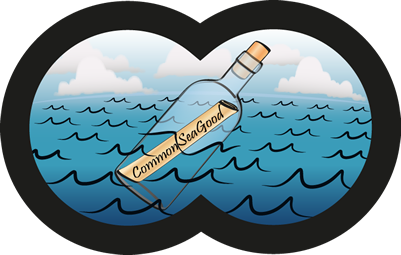The context
Since ancient times, the seas have always been an abundant source of healthy food for us. This is about to change dramatically!
Since World War II, the industrialization of fishing has led to a drastic decline of the biomass of large high trophic level fish, the carnivorous ones we prefer to eat, like tuna, swordfish, grouper, salmon or cod. Moreover, by fishing the largest individuals -the mega spawners- reproduction rates have been negatively affected and the natural stocks are struggling to rebuild even in a context of reduced fishing effort (which is unfortunately not the trend).
Since the 1990s or even before, the global wild fishing production has stagnate, despite greatly increased effort devoted to fishing with sonar-assisted super trawlers, fishing ever further from their home port and ever deeper in the oceans searching for new stocks to replace the already overfished traditional ones.
With global stocks in danger of being fished out, aquaculture was considered as the best alternative to wild fishing and became the fastest growing food-producing sector, contributing efficiently to the food security of our expanding human population.
The other side of the coin, though, is that marine animal proteins are needed, in quantity, to farm aquaculture fish species. Consequently, forage fish, which means low trophic level fish, like sardines, anchovy, herring, sprats, capelin, and other organisms, like krill or even copepods are now harvested from all possible ocean locations to supply this aquaculture industry.
This in itself is environmentally destructive, because these low trophic species are already the subsistence food for about one billion people who live in coastal communities as well as all the other higher trophic animals that depend on a healthy marine environment like other fish, seabirds and sea mammals.
We cannot use forage fish twice; their uncontrolled harvesting as fish feed is not sustainable. Sea mammals, seabirds and wild fish populations are drastically declining, while forage fish are progressively replaced by jellyfish in the habitats these fish previously occupied, and artisan fisherfolk have to work longer and sail further to earn less or stay at home. The growth of world aquaculture is also unsustainable if forage fish stocks are not able to recover because less wild fish means less natural fishmeal and fish oil can be included in farmed fish feed and the aquaculture farms are likely to produce a much poorer food for humans. Currently, we are duped twice!
Even without considering the effects of other marine threats like toxins, nutrient runoff eutrophication and petrolium or plastic pollution, this questionable practice of fishing down the food web, if unchecked, could ultimately drive so many fish species to extinction that only coelenterates will be left to dominate the diminished ecosystems. Do you want to eat polluted jellyfish in a near future ? I don’t.

(Fishing down the food web. Image © Hans Hillewaert inspired by the work of Daniel Pauly (Pauly et al., 1998)
My way

I’m Matthias Heilweck, from Alsace, France.
For over 30 years, alongside my bread-and-butter job, oceanography has been the focus of my spare time. Although I live about 1000 km away from the coast, I have always loved to read all the press articles and scientific publications I could find about this topic. Being a pragmatic ecologist with a Cartesian preference for logical analysis, I believe I have found a good way to help preserve the oceans as a healthy and sustainable food source for mankind. Between global pollution, overfishing and artificialisation of aquaculture, this may sound utopian, even pretentious.
However, I decided to publish here the synthesis of my reflections about the topic and thereby confront critical and constructive, I hope, analyses of them.
It all comes down to the development of a huge and healthy marine protein source, able to take over from wild forage fish, those small pelagic fish of low trophic levels, which are harvested today in all oceans solely to feed fish farms.
To achieve this my project still needs several relevant contributions from scientists, engineers, lawyers and other specialists. Obviously I will also need huge funds to finance the project, ![]() . This is unavoidable, even simple operations on the high seas are tremendously expensive. But the goal is a sustainable, ecology-friendly, healthy and scalable production of aquafeed on the high seas, which is created from almost nothing and is not taken from anyone. That, you must believe, is worth paying for.
. This is unavoidable, even simple operations on the high seas are tremendously expensive. But the goal is a sustainable, ecology-friendly, healthy and scalable production of aquafeed on the high seas, which is created from almost nothing and is not taken from anyone. That, you must believe, is worth paying for.
In the following sections, I will explain in detail:
- WHY it should be done
- HOW it can be achieved
- WHERE it can take place
- WHAT sort of marine organism can be raised.
It will perhaps not be always easy to read, I am not a novelist ![]() . However, if you have the patience to follow my brainstorming step by step through to the end, I am confident that you will admit that it makes sense.
. However, if you have the patience to follow my brainstorming step by step through to the end, I am confident that you will admit that it makes sense.
So here I am now, humbly publishing my conclusions in order to give them a chance to spread. In a sense, this is my message in a bottle, optimistically thrown into the ocean of the World Wide Web, initially on June 8th, 2014, a World Oceans Day, and updated since then, from time to time.
Follow me on My Project


